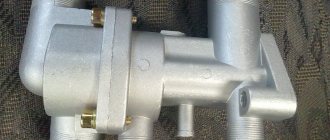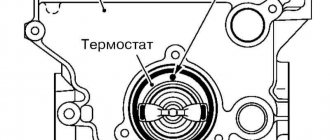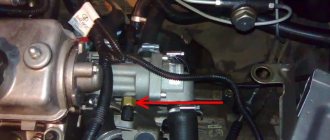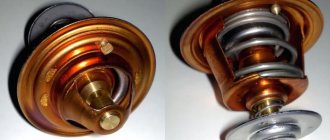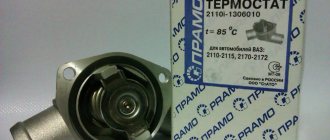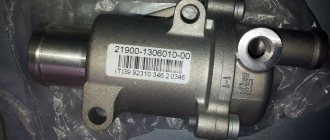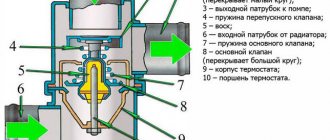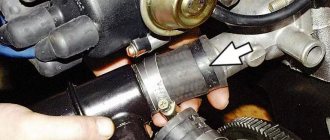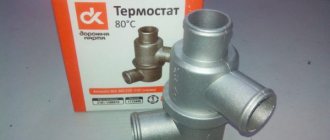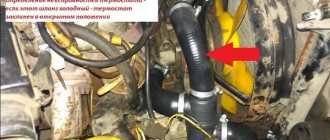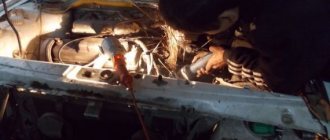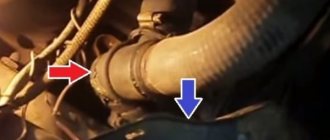Cars are improved from year to year. But despite the increase in engine power and volume, the liquid cooling system remains the same due to its high efficiency. One of the elements of this system is the thermostat. Its design is simple, but subject to certain malfunctions. Without proper control, this mechanism may fail. The article reveals the topic of why the thermostat is jammed, the main reasons for this phenomenon, signs of a malfunction of the thermostat, and important nuances of operation.
Device
Modern thermostats come in several types. The design depends on the volume of coolant in the system and the total pressure created by the water pump. 3 main designs:
- The simplest regulator with a non-separable brass body. It has only 3 pipes, as it is intended for small engines. Often installed on classic VAZ cars.
- A more advanced thermostat with a collapsible housing. Has more than 3 bends for connecting pipes.
- Similar to the previously described, but two-valve thermostat. Has 2 working locking mechanisms. It works on the principle of a single-valve regulator, but each valve closes a separate circulation circle.
Regardless of the model, the standard mechanism of this part consists of:
- Cylindrical, less often square, body made of brass, copper or aluminum.
- The body is equipped with tubular bends for attaching main rubber pipes.
- The main shutter valve, it is this that regulates the width of antifreeze circulation.
- The spring creates the necessary pressure on the valve when it is closed and returns it to the seat after opening.
- A special thermocouple consisting of a tube with a certain amount of wax inside.
- The rod contains all the components of the thermostat.
There are electronic thermostats that are similar in design, but are supplemented by a heating element and a power supply connector.
Principle of operation
The basic principle of operation of the thermostat is to alternately turn on the small and large cooling circles. This happens as follows:
- When the car is idle with the engine not running, the antifreeze temperature is approximately similar to the air temperature. In this case, the thermostat shutter valve is closed.
- After the engine has been started, the pump creates pressure for circulation, and due to the closed valve, the antifreeze circulates only in the engine/heater system. The radiator at this stage does not participate in cooling. The small volume of liquid and the closed cycle promotes rapid heating.
- As soon as the temperature of the cooling antifreeze crosses the threshold of 85 degrees, the thermostat opens, allowing the antifreeze to circulate in a large circle or throughout the entire system. This is necessary to balance temperature, pressure and maintain these values at a certain level.
This system was not invented by chance. It allows you to reduce the time it takes to warm up the engine and interior in winter, as well as maintain the operating temperature of the power unit at the temperature it requires.
Operating principle and functions of the thermostat
In order to confidently use the thermostat diagnostic methods proposed in the article, you will have to understand a few things. Namely:
- How does a thermostat work?
- Why is it needed at all?
- How does it perform its functions in good condition?
The thermostat works extremely simply. It is a valve that opens or closes when the coolant reaches certain temperatures. When the antifreeze is cold, the thermostat is closed. At temperatures above 80 °C (depending on the engine) - opens. This works due to the fact that inside the part there is a special capsule containing a mixture (wax based) that strongly expands when heated. When it heats up, its volume increases, the capsule presses on the rod and, overcoming the resistance of the spring, opens the valve.
Now let’s look briefly at why a thermostat is needed and what functions are assigned to it. To do this, consider the design of a car engine cooling system in a simplified form. And it consists of two circuits:
- Small circuit - includes the “water jacket” of the engine, as well as the radiator, which is used to operate the heater inside the car.
- Large circuit - includes all of the above, plus the main radiator and expansion tank.
The thermostat is installed in the system in such a way as to separate or communicate these two circuits at the right time. When the engine is still cold or has only reached normal operating temperature, the valve is completely closed. The coolant circulates only in a small circuit. Due to this, the engine warms up faster. In addition, you can turn on the heater earlier to heat the car interior in winter.
When the coolant temperature reaches a critically high temperature, the thermostat begins to open slightly according to the principle described above. Part of the hot antifreeze enters the main radiator, where it is cooled. Meanwhile, cold (or chilled) liquid flows into the small circuit. When the temperature in the small circuit decreases, the thermostat closes. Due to this, the nominal operating temperature of the engine is constantly maintained.
It should be noted that the thermostat valve does not necessarily open or close completely. It operates as the coolant temperature increases or decreases, and changes its throughput accordingly. This feature allows for smoother thermoregulation, due to which there are no sudden temperature changes in the system.
Let's sum up the intermediate results. A thermostat is needed in order to:
- a cold engine reaches operating temperature faster;
- Previously, it was possible to use the stove in the cabin;
- the coolant temperature was maintained at the required level;
- in case of overheating, lower the temperature in the small circuit by dumping some of the antifreeze into the main radiator for cooling.
That is, if there were no thermostat, the engine would take a long time to warm up, and in winter it would not reach operating temperature at all. To eliminate this problem, the volume of the cooling system would have to be reduced. But in this case, the engine will quickly overheat and boil. This is important to understand because part of the diagnosis described below is based on it.
Symptoms of malfunction
Often, due to improper care or operating errors, the thermostat fails. Symptoms of the malfunction are as follows:
- The engine takes a long time to warm up and does not reach operating temperature. In winter there is no heating at all. In this case, the engine loses some power and dynamism, and excessive fuel consumption occurs.
- The motor heats up very quickly and often overheats despite the fact that the fan and pump are working properly.
- Warming up occurs “intermittently”. When the power unit is first started, overheating occurs, but during further operation of the vehicle the problem does not appear. In this case, overheating can occur quite suddenly, especially at idle.
- The antifreeze level in the cooling system drops. This can be noticed when the machine is idle for a long time. Puddles form under the car, and air gets into the cooling system.
Any experienced car enthusiast knows the approximate time it takes to warm up the engine of a personal car. A cooling problem can be identified by increasing or decreasing the warm-up time. The main thing is to pay attention to signs of malfunction of the temperature control mechanism.
Symptoms and causes of malfunction
There are 3 types of failure of the temperature-sensitive element:
- the antifreeze passage to the main radiator does not open when heated;
- the damper is stuck in the half-closed position;
- the same, in a fully open state.
Note. These problems arise for two reasons: natural wear or low quality coolant, which produces deposits on the internal walls of pipes and system parts. A similar effect is achieved by pouring distilled and plain water.
In the first case, heated antifreeze cannot enter the main radiator and is cooled only in the cabin heater. As a result, the engine begins to overheat and the liquid begins to boil in the expansion tank. The malfunction is accompanied by the release of steam from the plug valve, a quiet hiss and critical thermometer readings on the instrument panel.
The most difficult time to determine a thermostat malfunction is when the damper has partially opened and is stuck in this position. A cold engine warms up sluggishly, and in operating mode the electric fan often turns on, forcing the radiator to cool. The problem is clearly identified during the summer heat, when half of the antifreeze circulates through a small circuit. The electric fan practically does not turn off, although overheating is not observed.
Important! Identical symptoms with an increase in temperature can be caused by another reason - the formation of an air lock in the car’s cooling system. Therefore, the thermostat must be carefully checked before replacement.
In the third case, the engine heats up to operating temperature only in the summer, since the antifreeze constantly moves in a large circle and is effectively cooled by the radiator. It is impossible to drive in winter - the stove does not heat at all.
Possible faults
There are not many common causes of malfunction. These include:
- The thermostat is stuck in the closed position of the valve cup. This leads to overheating of the antifreeze.
- The thermostat is stuck in the valve cup open position. Warming up of the engine slows down significantly.
- The regulator is stuck in an intermediate position, that is, its shutter mechanism is not fully open. Poor heating occurs while driving and overheating occurs when the power unit is idling.
- The thermostat opens ahead of schedule. Leads to slower heating.
- For models with electronically controlled opening, the valve does not open at all. This causes the antifreeze to boil.
Each malfunction has a number of reasons. Each will be described in detail below.
Closed position
This malfunction occurs most often. The reasons for such a problem may lie in the nuances of operating the machine. The thermostat does not open if:
- Too much scale, dirt, and oxidation have accumulated in its mechanism. The reason may be the use of ordinary tap water instead of antifreeze. Many people dilute antifreeze with distilled water, which also leads to scale formation in the system.
- Inappropriate antifreeze has been selected for the cooling system. Coolants are divided according to the degree and temperature of heating. If the thermostat response threshold is many times lower than the boiling point of the antifreeze, the opening time of the regulator will increase, which will lead to overheating.
- The return spring breaks or loses tension. The cause may be the device itself if it is not manufactured to the required standards. Often new regulators from unscrupulous manufacturers suffer from this problem. The spring may wear out from using water for cooling. Water oxidizes and reduces the life of the metal.
- The thermostat does not open due to a broken valve cup mounting. The reasons are similar to a broken spring.
- Failure of the thermoelement. This part becomes unusable due to breakdown or deformation of the tube in which the wax is enclosed. This element is very sensitive, since its work is based on the pressure created during expansion from heating.
- Electronic thermostats suffer from the problem of complete jamming due to a faulty thermistor, oxidation of the power connector contacts, or an open circuit. Often the cause may be a temperature sensor that is unable to determine the current system temperature.
All these features must be taken into account in the process of selection and further operation of this unit.
The working thermostat does not open!
I replaced the thermostat (used original, working), due to a cold lower pipe on a fully warmed up car. The problem hasn't gone away! The engine warms up, the fans turn on at speed 1 - the lower pipe is cold; 2nd speed - cold. Further, if the stove heats up completely, then the fans reduce the speed to 1st, but do not turn off! The bottom pipe is constantly cold. Thoughts: 1. It turns out that either the DTOZh gives the wrong command to turn on the fans, but the vehicle does not open, there is not enough temperature. 2. TS-2 is also crap, although I checked the removed one - it opens normally, but only by about 0.5 cm, I don’t know if this is normal or not? 3. There is not enough circulation (airiness of gases through the cylinder head, pump). Here is the following: on the neck of the base. put on a glove on the radiator, put a large funnel in - not a single thing was visible in the breakthrough of gases, nor any gases through the expander hose; pump - what could be wrong with it? does not leak, the belt rotates normally, i.e. the pump would somehow manifest itself if the bearing jams or falls apart. The stove heats normally, even well; The temperature on the dashboard is normal!; The engine warms up normally, as usual! Yes, SG5 cars, atmospheric, 2.0, mileage = 285.
I read somewhere here that this happens
when the diagnostic connectors are closed. I don’t pretend to be correct; now more knowledgeable people will come along and clarify the situation.
The lower pipe should be cold - the flow FROM the radiator goes there. And the thermostat is washed by the flow of liquid from the stove (small circle). Provided you didn't put it upside down.
I will allow myself to disagree with your authoritative opinion: I can imagine the theory of what goes where and what it is washed with! The lower pipe should be warm (when the vehicle is opened)! Compared to the top one, one could probably call it cold, but still. )) Really - it’s really cold (there’s no mistaking it), and the entire lower part of the radiator is also really cold! The vehicle was inserted correctly, you can rest assured)) And the fans turn on very quickly, literally, as soon as the temp arrow shows on the display meter. falls into place! And they don't turn off! And if you turn off the stove, they go back to speed 2 very quickly and don’t turn off either. The car is idling, that is, it’s not going anywhere, and it’s not winter outside (well, it was actually in the garage))) The connectors are not closed. Here by)) Yes, experiment: fans on the 2nd, on. heater to maximum, I begin intensive artificial respiration)), that is, I actively squeeze the upper hose for a minute or two, it feels like my hand is tolerating the temperature, then the temperature in the hose rises (which my hand can’t tolerate), apparently it’s gone bad -no circulation, the hottest antifreeze comes into the upper hose and, lo and behold, the fans switch to first and then off, but not for long! And the bottom one is just that - cold!
I think, after all, the DTOZH is to blame: the temperature is extremely insufficient to open the vehicle, and the ECU takes the word of the DTOZH (faulty) one, that’s why the ventilators turn on! Well, maybe it’s still true, the cylinder head is blown into the CO, it’s all sad! But I couldn’t detect a breakthrough of gases in the CO, maybe someone can give detailed advice on how to check the gas content of CO (maybe I checked it wrong). Yes, the top can of the radiator has been converted to aluminum (for more than a year now), there are suspicions that the radiator cap is not tall enough to open (i.e. the neck is not the right size), but this is nonsense in my opinion)
Last edited by MChPV; 28.11.2015 at 08:21.
LT1. Cooling and heating systems. Volkswagen LT Club
- Unanswered topics
- Active topics
- SearchMobile version
Open position
If the thermostat does not warm up the power unit in a timely manner, it means it is stuck in the open position. Possible reasons are as follows:
- Dirt or foreign objects getting into the shutter mechanism. These could be large pieces of scale, parts of sealant or gaskets.
- Spring failure due to metal rotting.
- The valve cup fastening is distorted or broken. Also occurs due to the use of water.
All these malfunctions often occur when the rules for operating the cooling system are not followed.
Half open position
This problem can arise due to foreign parts of gaskets and sealant getting under the locking cup. The cause may also be depressurization of the system and air leaks from the outside. Air pockets increase the pressure in the system. During a visual inspection, it is necessary to find and eliminate all antifreeze leaks at the joints of the pipes.
If the valve is not fully open, you should pay attention to an additional fan if the car is equipped with one. In such systems, cooling is divided into periods during which the 2nd fan is turned on. If it fails, the valve will open halfway, since the antifreeze temperature is at an intermediate value.
Where is it located
There are many options for what will happen if the thermostat is constantly open on a large or small circle. This will lead to overheating, antifreeze may be released from the expansion tank, the normal pressure in the cooling system will change, and more.
This unit cannot be allowed to malfunction. It is used on all machines:
- on Kalina;
- on Priora;
- VAZ 2114;
- VAZ Classic;
- Ford Focus;
- VAZ 2110;
- Chevrolet Aveo;
- Gazelle Next;
- VAZ 2107;
- Lada Granta;
- Renault Logan, etc.
To check the serviceability of this element on a car, as well as to detect signs of a dying thermostat, you need to at least roughly understand where it is located.
I can't say it's difficult to do.
It is objectively correct to immediately look at the instruction manual. In the section where the cooling system is described, the location of the required element must be indicated.
At the same time, there is a fairly universal search method that is relevant for almost all domestic cars and many foreign cars.
To find a thermostat you need to do the following:
- open the hood;
- find the thickest pipe;
- this will be the radiator hose;
- it goes from the radiator to the engine;
- the second end of this pipe is connected to the thermostat;
- get to the second end;
- determine the location of the thermostat housing;
- start removing it.
Although I still advise you to first look at the manual, and only then start searching, dismantling and repair work.
Important
It is extremely important to diagnose and repair thermostat malfunctions in a timely manner. You cannot operate a vehicle with a damaged circulation control element. Insufficient heating of the power unit will affect power, dynamism, and increased fuel consumption. Excessive heating and frequent overheating with boiling of antifreeze can lead to problems with the piston group and depressurization of the cylinder head. Such repairs are very complex and expensive. On modern cars, any problems with the cooling system are transmitted to the engine control unit. The ECU will react to problems and make adjustments to the operation of other systems, which will affect the overall performance of the machine.
